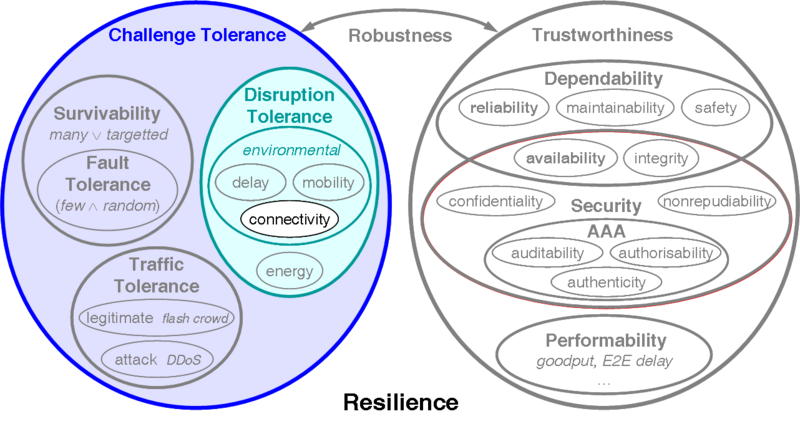Weak and Episodic Channel Connectivity
Contents |
Interference and Jamming
[Chen-Chen-Sun-Zhang-2007 (doi) .]
Wei Chen, Danwei Chen, Guozi Sun, and Yingzhou Zhang
“Defending Against Jamming Attacks in Wireless Local Area Networks”,
Autonomic and Trusted Computing, vol.4610/2007, August 2007, pp. 519–528
Keywords: RTS, CTS, CUSUM, Jamming
Abstract: “Wireless local area networks(WLANs) work upon a shared medium and broadcast data frames via radio waves. These features let legitimate users connect to Internet conveniently at WLAN access points but also let a malicious attacker misuse network flexibly. Attackers can launch jamming attacks by exploiting vulnerabilities in 802.11, which is a dominant protocol used by WLAN. We discuss two jamming attacks, RTS and CTS jamming, and address their attacking conditions and threats. To defend against jamming attacks, a CUSUM based detection method is proposed, which can accurately detect jamming attacks with little computation and storage cost. When continuous attacking packets are sent out, a change-point will appear in a traffic sequence. Our detection method is capable to observe such change-points and then launch alarms. The efficiency of defense methods is verified by simulation results.”
[Xu-Trappe-Zhang-Wood-2005 (doi) .]
Wenyuan Xu, Wade Trappe, Yanyong Zhang and Timothy Wood
“The Feasibility of Launching and Detecting Jamming Attacks in Wireless Networks”,
MobiHoc, May 2005
Keywords: Denial of Service, Jamming, Jammer Detection
Abstract: “Wireless networks are built upon a shared medium that makes it easy for adversaries to launch jamming-style attacks. These attacks can be easily accomplished by an adversary emitting radio frequency signals that do not follow an underlying MAC protocol. Jamming attacks can severely interfere with the normal operation of wireless networks and consequently, mechanisms are needed that can cope with jamming attacks. In this paper, we examine radio interference attacks from both sides of the issue:First, we study the problem of conducting radio interference attacks on wireless networks, and second we examine the critical issue of diagnosing the presence of jamming attacks. Specifically, we propose four different jamming attack models that can be used by an adversary to disable the operation of a wireless network, and evaluate their effectiveness in terms of how each method affects the ability of a wireless node to send and receive packets. We then discuss different measurements that serve as the basis for detecting a jamming attack, and explore scenarios where each measurement by itself is not enough to reliably classify the presence of a jamming attack. In particular, we observe that signal strength and carrier sensing time are unable to conclusively detect the presence of a jammer. Further, we observe that although by using packet delivery ratio we may di®erentiate between congested and jammed scenarios, we are nonetheless unable to conclude whether poor link utility is due to jamming or the mobility of nodes. The fact that no single measurement is sufficient for reliably classifying the presence of a jammer is an important observation, and necessitates the development of enhanced detection schemes that can remove ambiguity when detecting a jammer. To address this need, we propose two enhanced detection protocols that employ consistency checking. The first scheme employs signal strength measurements as a reactive consistency check for poor packet delivery ratios, while the second scheme employs location information to serve as the consistency check. Throughout our discussions, we examine the feasibility and effectiveness of jamming attacks and detection schemes using the MICA2 Mote platform.”
Weather Challenged Links
[Gremont-Filip-2004 (doi) .]
Boris Christian Grémont, and Miodrag Filip
“Spatio–Temporal Rain Attenuation Model for Application to Fade Mitigation Techniques”,
IEEE Transactions on Antennas and Propagation, vol.52, #5, May 2004, pp. 1245–1256
ResiliNets Keywords: challenged link, disruption tolerance, weak connectivity, physical layer
Keywords: Diversity, dynamic, propagation, rain, statistics
Abstract: “We present a new stochastic-dynamic model useful for the planning and design of gigahertz satellite communications using fade mitigation techniques. It is a generalization of the Maseng–Bakken and targets dual-site dual-frequency rain attenuated satellite links. The outcome is a consistent and comprehensive model capable of yielding theoretical descriptions of: 1) long-term power spectral density of rain attenuation; 2) rain fade slope; 3) rain frequency scaling factor; 4) site diversity; and 5) fade duration statistics using a novel method based on Markov Chains. We also present a simple rain attenuation synthesizer matching the predictions of the theoretical model”
Notes: This paper presents a model for rain fades in wireless link.
